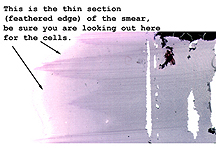|

General
and Systemic Histopathology, C601&C602
Looking at blood smears can be a
little tricky. First, this is one of the few situations in which you may need
to use your oil immersion lens. Please be careful. It's easy to run it through
a slide. Knowing where to look on the slide can make all the difference
between being able to see what's there, and frustration.
- You want to be way out on what
we call the 'feathered edge' of the slide. That is, you
want to be in the shallow end of the blood smear, not in the middle of the
slide.
- You need to find an area where the RBC's just barely
touch each other, or are free swimming. If you are looking at an area where
the RBC's are piled on top of one another and the WBC's are dark and small,
keep going to the thinner end of the slide.
When you study a smear,
remember there are three formed elements to assess, plus what can be
learned from the background. No matter what you have been told about the
disease the slide represents, always look at the
- RBC's,
- WBC's and
- Platelets.
The degree of blue staining in the
background can also give you an indication of the amount of protein in the
blood. The darker blue the background, the more there is. But again, be sure
you are looking in the far reaches of the feathered end of the slide.
What follows are
real live clinical stories, some with happy outcomes and some otherwise.
|